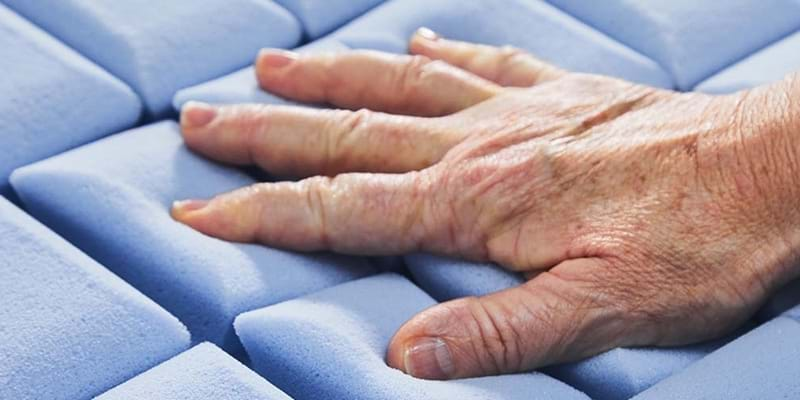
Client Mobility and Choice of Mattress
When a client or patient needs a mattress, there are often a number of questions that recur. What wound stage does it cover? Should it be foam, air, or both? And should the mattress be with or without a pump? But another element which is often overlooked is also important when choosing a mattress.
By: Occupational Therapist, Pia Beck
Pressure Measurements and Wound Stages
When choosing a mattress providing the proper support and adequate pressure redistribution is critical.
For many years, wound stages and subsequent mattress pressure measurements have guided the choice of mattress and the professional discussion about mattresses in hospital and care settings.
This has meant that discovering a pressure sore or redness on the client’s skin has become equivalent to requisitioning an alternating pressure ulcer mattress and initiating a patient repositioning regimen.
Although assessing the wound stage and the pressure measurements of the mattress are important, these elements should not stand alone as they have been for the past many years.
Scoring Tools
The Braden scale (see below) or other similar scales are popular and useful tools that help assess whether a client is at risk of developing a pressure sore. The scale predicts the risk of a pressure ulcer based on 6 parameters: sensory perception, moisture, activity, mobility, nutrition, and friction or shear.
Unfortunately, the results of a score on the Braden Scale and similar scoring tools are often used as answer books rather than guides.
| Sensory perception Ability to react meaningfully to pressure related discomfort |
|
|
|
Moisture |
|
|
| Aktivitet Degree of physical activity |
|
|
| Mobility Ability to change and control position |
|
|
| Nutrition Usual eating habits |
|
|
| Friction and shear |
|
Braden Scale. The patient is ranked within each category and the overall score reveals whether there is a high, medium, or low risk of developing a pressure ulcer. A score of 19-23 indicates low risk. A score of 12-18 indicates a medium risk. And a score of 6-11 indicates a high risk.
As such it has become normal practice to automatically acquire an alternating air mattress if the client scores low in total (and thus is considered to be at high risk of developing tissue damage). This can be an issue, if the clients scored low overall but ranked high in mobility level.
In this case, the client risks having their mobility further limited by the alternating air mattresses, which consist exclusively of high air cells, and not even being able to make the small micro-movements that we all make approx. every 10 minutes when we sleep.
These small micro-movements are of great importance for the stimulation of the tissue and without them, we are at great risk of developing tissue damage.
In this way, the choice of mattress, based on a scoring scale alone, can worsen tissue damages in some patients if a professional assessment of their mobility level is not made at the same time.
We suggest that it is necessary to score the client using the Braden Scale and then evaluating their mobility again separately. If the client scores high on mobility, an active mattress should not be necessary.
Instead, a good foam mattress that allows the client to continue to move as much as their level of mobility allows, could be a solution. If assessed that the client does not have sufficient resources to move, or does not get repositioned sufficiently, the foam mattress can be complemented with a micro-positioning regimen.
Assessing the Root Cause of The Wounds
For existing wounds, the wound category, the location of the wound, and the type of wound can determine which pressure-relieving functions the mattress should have. This is because not all wounds are caused by pressure, and it is, therefore, necessary that we find the cause of the wound if we want to choose the right mattress.
Are there e.g., only wounds on the heels, a reactive mattress with a pressure-relieving heel zone can be a good solution. If, on the other hand, there are sores on the coccyx/sacrum, it may be due to shear and friction when elevating the back of the bed, and a reactive foam mattress, such as our DORMILET Flexi, can be a good solution as it has a friction-reducing slide zone. However, if the root cause of a wound is in fact pressure and the client's mobility level is poor, then an active mattress must be used.
How to choose the right mattress
There is undoubtedly a great desire to reduce the number of wounds, as wounds have major consequences for the individual client, and the cost of wound treatment is staggeringly high.
A step in the right direction is choosing the right mattress.
When choosing the right mattress for a client, our advice is, therefore:
- Let the mobility level determine whether you need an active or a reactive mattress. If the client is completely immobile, an active mattress is necessary. However, if the client has little mobility, a reactive mattress combined with repositioning can be a better solution.
- Find the cause of the wound before ordering a mattress; is it pressure, shear, friction, maceration, or delamination of the skin that is to blame for the wound? Not all wounds can be healed using a pressure-relieving mattress. If the wound has occurred by lifting out of the bed, in the wheelchair, or by using the bed's profiling properties, a new mattress may not necessarily be needed.
- Remember to focus on preventative efforts rather than just treatment; Make sure that all employees are knowledgeable of different wound types and their causes, as well as being familiar with repositioning methods.
- Use your professionalism; Do not let guidelines, procedures and scoring scales overshadow the individual, clinical assessment of the client's needs.
